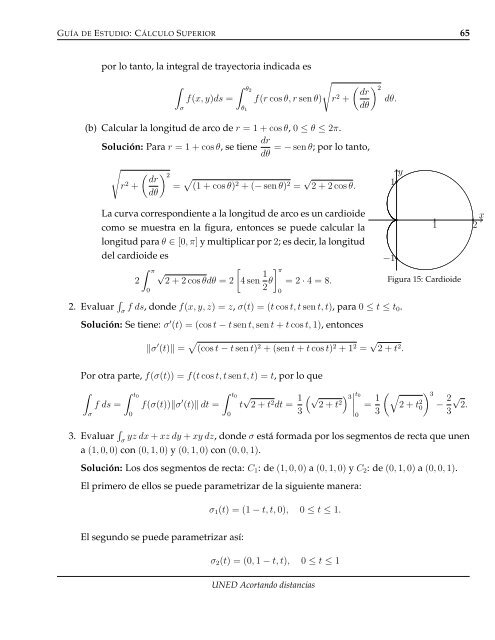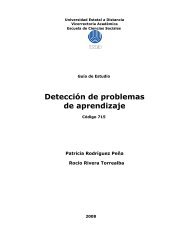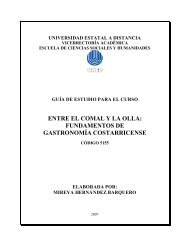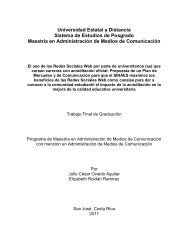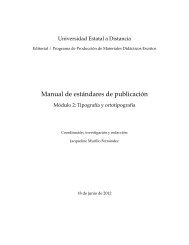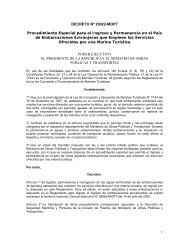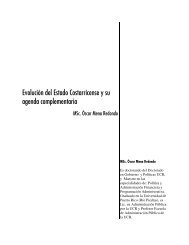GE3011 Cálculo Superior - Repositorio de la Universidad Estatal a ...
GE3011 Cálculo Superior - Repositorio de la Universidad Estatal a ...
GE3011 Cálculo Superior - Repositorio de la Universidad Estatal a ...
Create successful ePaper yourself
Turn your PDF publications into a flip-book with our unique Google optimized e-Paper software.
GUÍA DE ESTUDIO: CÁLCULO SUPERIOR 65<br />
por lo tanto, <strong>la</strong> integral <strong>de</strong> trayectoria indicada es<br />
<br />
σ<br />
θ2<br />
f(x, y)ds = f(r cos θ, r sen θ)<br />
θ1<br />
<br />
r 2 +<br />
(b) Calcu<strong>la</strong>r <strong>la</strong> longitud <strong>de</strong> arco <strong>de</strong> r = 1 + cos θ, 0 ≤ θ ≤ 2π.<br />
Solución: Para r = 1 + cos θ, se tiene dr<br />
= − sen θ; por lo tanto,<br />
dθ<br />
<br />
r 2 +<br />
2 dr<br />
=<br />
dθ<br />
(1 + cos θ) 2 + (− sen θ) 2 = √ 2 + 2 cos θ.<br />
La curva correspondiente a <strong>la</strong> longitud <strong>de</strong> arco es un cardioi<strong>de</strong><br />
como se muestra en <strong>la</strong> figura, entonces se pue<strong>de</strong> calcu<strong>la</strong>r <strong>la</strong><br />
longitud para θ ∈ [0, π] y multiplicar por 2; es <strong>de</strong>cir, <strong>la</strong> longitud<br />
2 dr<br />
dθ.<br />
dθ<br />
x .<br />
1 2<br />
<strong>de</strong>l cardioi<strong>de</strong> es<br />
π<br />
<br />
√<br />
2 2 + 2 cos θdθ = 2 4 sen<br />
0<br />
1<br />
2 θ<br />
−1<br />
π = 2 · 4 = 8.<br />
Figura 15: Cardioi<strong>de</strong><br />
0<br />
2. Evaluar <br />
f ds, don<strong>de</strong> f(x, y, z) = z, σ(t) = (t cos t, t sen t, t), para 0 ≤ t ≤ t0.<br />
σ<br />
Solución: Se tiene: σ ′ (t) = (cos t − t sen t, sen t + t cos t, 1), entonces<br />
.<br />
y<br />
1<br />
σ ′ (t) = (cos t − t sen t) 2 + (sen t + t cos t) 2 + 1 2 = √ 2 + t 2 .<br />
Por otra parte, f(σ(t)) = f(t cos t, t sen t, t) = t, por lo que<br />
<br />
σ<br />
t0<br />
f ds = f(σ(t))σ ′ t0<br />
(t) dt =<br />
3. Evaluar <br />
σ<br />
0<br />
0<br />
.. .<br />
t √ 2 + t2dt = 1<br />
√ t0 3 2 + t2 =<br />
3<br />
0<br />
1<br />
<br />
2 + t<br />
3<br />
2 3 0<br />
− 2√<br />
2.<br />
3<br />
yz dx + xz dy + xy dz, don<strong>de</strong> σ está formada por los segmentos <strong>de</strong> recta que unen<br />
a (1, 0, 0) con (0, 1, 0) y (0, 1, 0) con (0, 0, 1).<br />
Solución: Los dos segmentos <strong>de</strong> recta: C1: <strong>de</strong> (1, 0, 0) a (0, 1, 0) y C2: <strong>de</strong> (0, 1, 0) a (0, 0, 1).<br />
El primero <strong>de</strong> ellos se pue<strong>de</strong> parametrizar <strong>de</strong> <strong>la</strong> siguiente manera:<br />
El segundo se pue<strong>de</strong> parametrizar así:<br />
σ1(t) = (1 − t, t, 0), 0 ≤ t ≤ 1.<br />
σ2(t) = (0, 1 − t, t), 0 ≤ t ≤ 1<br />
UNED Acortando distancias


